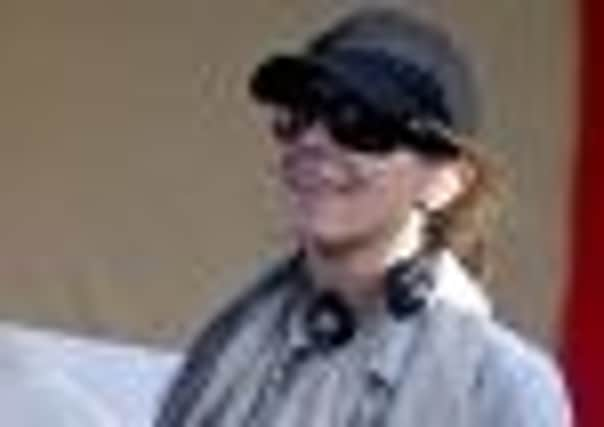Kathryn Bigelow: Director’s pride in the telling of gritty true story


At this year’s Golden Globes ceremony, Jessica Chastain paid special thanks to her director Kathryn Bigelow.
“I can’t help but compare my character to you, to a powerful, fearless woman that allows their expert work to stand before them,” said Chastain after receiving the award for her portrayal of Maya, a CIA agent who dedicates her life to hunting Osama bin Laden in Bigelow’s latest movie, Zero Dark Thirty.
Advertisement
Hide AdAdvertisement
Hide AdBigelow may not have set out to break gender rules with ‘macho-themed’ movies, such as the iconic surfer-cop tale Point Break, the real-life naval account K-19: The Widowmaker, and the Iraq-based bomb disposal tale The Hurt Locker (for which she became the first female to receive an Oscar for directing), but as Chastain observed, she’s successfully managed to “disobey the conventions of Hollywood”.


“That’s not, let’s say, a reason to engage in a particular topic,” says Bigelow, who at 61 looks incredible in knee-high boots, jeans, T-shirt and fitted jacket.
“What’s interesting to me is the topicality of something,” she says. “Certainly with The Hurt Locker and Zero Dark Thirty, it’s the fact these are stories that are almost contemporaneous with our lives. There’s an urgency, a resonance and a topicality that, as a filmmaker, makes it very stimulating and exciting material to work with.”
Following the terrorist attacks on September 11, 2001, the hunt for Osama bin Laden preoccupied the world for more than a decade.
Advertisement
Hide AdAdvertisement
Hide AdIn the end, it took a small, dedicated team of CIA operatives to track him down to a compound in Abbottabad, Pakistan.
“It’s the story of finding a very sharp needle in a very large haystack,” notes Bigelow.
“Once bin Laden escaped from Afghanistan, he fenced himself in with a byzantine network that took years and years to unravel.”
Every aspect of the operatives’ mission was shrouded in secrecy and, while some of the details have since been made public, many of the most significant parts of the intelligence operation are brought to the screen for the first time in Zero Dark Thirty (the military code for the time – 12.30am – when the Navy SEALS first stepped into bin Laden’s hiding place).
Advertisement
Hide AdAdvertisement
Hide AdBigelow says: “The war on terror has touched everybody around the world, especially the families of 9/11 and military intelligence professionals, and it was a real honour to tell a story of that long, dark decade between 9/11 and May 1, 2011 (the date on which bin Laden was killed by the SEALS).”
The greatest creative challenge posed to Bigelow and Mark Boal – the journalist-turned-screenwriter and producer of both this movie and The Hurt Locker – was how to tell a multi-faceted story within the time-frame of a movie.
“That was tricky because you’ve got masses of information and you’re compressing it into two-and-a-half hours,” says California-born Bigelow. “But the events were inherently very dramatic and the narrative kind of lined up fairly well, certainly around the main characters.”
The project actually began as a film about the failure to capture bin Laden in Tora Bora; the crew was in pre-production when they heard that bin Laden had been killed. Boal, who’s been Bafta and Oscar nominated for his screenplay, had to start again.
Advertisement
Hide AdAdvertisement
Hide Ad“For me, it was interesting to give the audience a glimpse inside the intelligence community and inside an operation that was so incredibly complex and definitely successful but against impossible odds,” says Bigelow.
Chastain plays Maya who, over the decade, metamorphoses from shell-shocked new recruit to steely navigator. Along with the audience, Maya is plunged into the hunt for bin Laden by witnessing the unsettling experience of an “enhanced interrogation” sequence with an Al Qaeda detainee.
The controversial scenes – which depict the use of the torture technique waterboarding during the early stages of the hunt – have sparked global debate, but Bigelow stands by her decision to include them.
“As a human being I wanted to cover my eyes, but as a filmmaker, I felt a responsibility to document and bear witness,” she says. “I think in a way it’s a compliment to the film to stimulate such a vital conversation. It’s only disappointing when the film is mischaracterised,” she adds.
Advertisement
Hide AdAdvertisement
Hide Ad“Actually I was just so honoured to tell this story. I think of it as a story of a lifetime, so I was just very excited and very proud.
“I’m excited the film is performing so well at the box office.”
Women director Oscar contenders
Kathryn Bigelow may be the only female to win an Oscar for directing but these women came close:
In 1977, Lina Wertmuller became the first female director to be nominated. The Italian language film Seven Beauties was about a man trying to survive in a concentration camp.
Advertisement
Hide AdAdvertisement
Hide AdJane Campion was nominated for a Best Director Oscar in 1994, for her melancholic film The Piano starring Holly Hunter as a mute pianist in 19th century New Zealand.
Sophia Coppola was nominated in 2004 for Lost In Translation, starring Bill Murray.